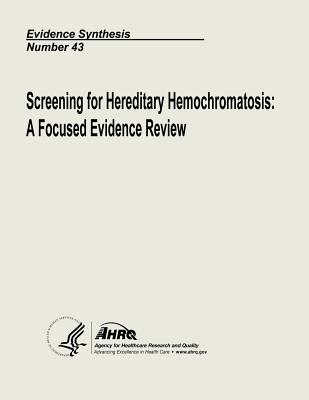Screening for Hereditary Hemochromatosis is a topic that has not been previously considered by the United States Preventive Services Task Force (USPSTF) for a possible recommendation as a clinical preventive service for primary care clinicians. This product is a pilot approach to systematically review the sufficiency of evidence for a focused (as opposed to comprehensive) set of key questions related to two main USPSTF screening criteria: the burden of suffering and the potential effectiveness of a preventive intervention, therapeutic phlebotomy. The USPSTF considers conditions of major significance that are relatively common in the U.S. to be candidates for preventive interventions, such as screening. Also, for a condition to be a candidate for a USPSTF screening recommendation, there must be evidence that persons with the condition detected early have a better clinical outcome that those detected without screening. Key questions for this review were limited to what the USPSTF judged to be critical evidence gaps in establishing these requirements. Key questions were constructed and applied using strict and consistent definitions of disease, which are described in more detail below. The resulting report is intended to demonstrate evidence sufficiency or insufficiency as its primary aim, and thus does not have the usual breadth associated with a USPSTF systematic evidence review. Hemochromatosis (HC) was originally thought to be a rare idiopathic disorder characterized by end-stage disease (cirrhosis, diabetes, and bronzed skin), but is now recognized as often having a hereditary component due to an autosomal recessive inherited disorder of iron metabolism. In HC, body iron accumulates and can lead to iron overload. In iron overload, excess iron is deposited in the liver, pancreas, heart, joints, and endocrine glands, resulting in tissue damage that may lead to one or more disease conditions (e.g., cirrhosis, diabetes, increased skin pigmentation, heart failure, arthropathy, and impotence). Iron overload can be primary (as in hereditary hemochromatosis) or secondary (e.g., due to anemias with inefficient erthropoeisis or repeated blood transfusions). Key questions addressed include: Key Question 1. Among those with a homozygous C282Y genotype, what is the risk of developing clinical hemochromatosis? Key Question 2. Does earlier therapeutic phlebotomy of individuals with primary iron overload due to HH reduce morbidity and mortality compared with treatment after diagnosis in routine clinical care? Key Question 3. Are there group(s) at increased risk for developing HH that can be readily identified prior to genetic screening?
| FindBook |
有 1 項符合
Screening for Hereditary Hemochromatosis: A Focused Evidence Review的圖書 |
 |
Screening for Hereditary Hemochromatosis: A Focused Evidence Review 作者:U. S. Department of Health and Human Services(COR)/ Agency for Healthcare Research and Quality (COR) 出版社:Createspace Independent Publishing Platform 出版日期:2013-06-26 語言:英文 規格:平裝 / 98頁 / 27.9 x 21.6 x 0.5 cm / 普通級 |
| 圖書館借閱 |
| 國家圖書館 | 全國圖書書目資訊網 | 國立公共資訊圖書館 | 電子書服務平台 | MetaCat 跨館整合查詢 |
| 臺北市立圖書館 | 新北市立圖書館 | 基隆市公共圖書館 | 桃園市立圖書館 | 新竹縣公共圖書館 |
| 苗栗縣立圖書館 | 臺中市立圖書館 | 彰化縣公共圖書館 | 南投縣文化局 | 雲林縣公共圖書館 |
| 嘉義縣圖書館 | 臺南市立圖書館 | 高雄市立圖書館 | 屏東縣公共圖書館 | 宜蘭縣公共圖書館 |
| 花蓮縣文化局 | 臺東縣文化處 |
|
|
圖書介紹 - 資料來源:博客來 評分:
圖書名稱:Screening for Hereditary Hemochromatosis: A Focused Evidence Review
|











